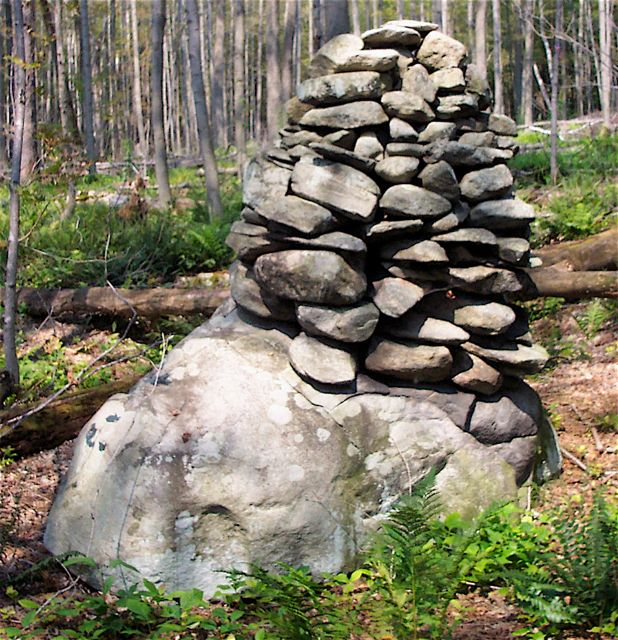Above is a “pile” of well-stacked stone on a boulder somewhere in western New England. This activity would have helped clear a field or pasture. But more importantly, it turned the mundane act of clearing land into a stacking game, leaving cairns and stacks for us to puzzle over and misinterpret as sacred sites.
Yesterday, I learned of a curious case of stonework performed by an elderly man with dementia. The anecdote, published in the Providence Journal for September 2, 1895, refers to a time “60 years ago,” which dates the case to the mid 1830s. In this case, the stonework was done as “keep-busy” therapy for an aging farmer with dementia, a reason not usually cited as an explanation for odd stone structures found throughout New England.
It is one of the few cases in my experience where the origin of stone structures –walls, piles, enclosures, cairns– is specifically documented in time, place, and purpose. The lesson here is that odd stone structures need not be expedient or symbolically sacred. Unless proven otherwise, those dating to before and after European contact might reflect little more than individualistic, idiosyncratic responses to behavioral cues.
Specifically, an “uncle of the owners” living on “the Josiah Dyke place” in northeastern Connecticut, likely East Thompson, had dementia (also known as senility), the condition of losing one’s mind –especially one’s memories– as part of the aging process. This particular uncle “spent his whole time in the fields, which are full of stones of all sizes, picking up the stones and placing them with great care in heaps” that were “piled up without mortar into pyramids” that “tapered slightly and reached a height of six feet or more.” They were “so well and so solidly built that although built 60 years ago they are still in as good condition as ever, except where mischievous boys have torn them down.” “The work was so well done that it became a wonder of the countryside,” bringing gawking visitors in “from far and near.”
The stones remain as a testament to dementia, a condition that plagues millions of adults today, and to the value of stonework in happily passing the time as a form of engagement with the world, even when one’s mind is slip sliding away. I know this condition from direct experience because my own 96-year old father has it today. Being a former band conductor, he physically directs the musical memories floating through his mind. Another resident of his managed care facility knits while she walks, again a response to the urge to do something physical. Had my father been the farmer’s uncle from 19th century New England, however, he might have felt the urge to stack stone to occupy his mind to pass the time away.
My favorite aspect of this story is that the micro-history of this demented builder faded away in only six decades. Cultural memory and individual memory both fade away, leaving archaeology to fill in the gaps.
NOTE: This anecdote is based on an excerpt sent to me by Dr. Tim Ives, the Rhode Island state archaeologist. The original is below the line. Note that the location is given as “northwestern” Connecticut when it is almost certainly “northeastern,” an easy mistake to make by the author.
“This is not the only curiosity of this region, for the whole country in northwestern Connecticut is full of eccentricities of nature and man. On the Josiah Dyke place, in this region, are a number of curious heaps of stones, piled up without mortar into pyramids wThey were placed there over half a century ago by an uncle of the owners of the property. He was demented and spent his whole time in the fields, which are full of stones of all sizes, picking up the stones and placing them with great care in heaps which tapered slightly and reached a height of six feet or more. The work was so well done that it became a wonder of the countryside, and people came from far and near to look at the stone heaps. Now they remain in the fields, visible from the road, although their builder has long since passed away, and few of the farmers in the locality know their history.”
